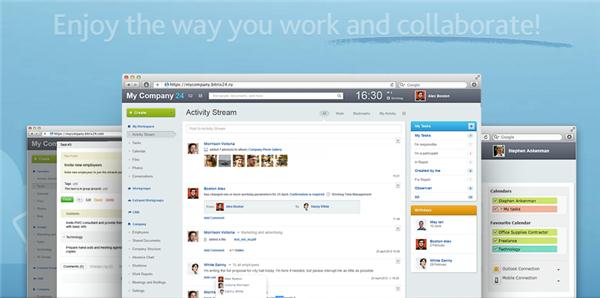
A lot of businesses have a hard time quantifying their company culture.
In the absence of a formal vision and a strategy to support it, culture usually devolves into variations on the “golden rule.”
Be nice.
Respect your co-workers.
Avoid gossip.
Or, as Michael Scott of NBC’s The Office eloquently puts it:
My philosophy is basically this,and this is something that I live by, and I always have, and I always will: Don’t ever, for any reason, do anything, to anyone, for any reason, ever, no matter what, no matter where, or who, or who you are with, or where you are going, or where you’ve been, ever, for any reason whatsoever.”
But what if company culture could actually be a tangible, measurable reality in your organization, instead of a few cheap truisms, and what if your human resource management software had a lot to do with that?
Well, it can, and it does.
Defining Company Culture
“Company culture” usually makes you think of the trendsetters — companies like Google, Apple, Zappos, or HubSpot — where employees dress casually, set their own hours, drink beer on the clock. And where a constant horde of applicants is dying to get in.
It’s every HR director’s dream to have a company culture that simultaneously keeps employees engaged and attracts new talent. There are obvious benefits to this. For starters, you’ll lose fewer employees. The average likelihood of job turnover at an organization with strong work culture is only 14 percent, compared with almost 50 percent for organizations with weak culture.
A positive company culture also makes employees happy, which means they’ll work harder. Happy workers are 12 percent more productive than unhappy workers, according to the University of Warwick.
But how can you define and execute company culture in a way that addresses both its operational and psychological elements?
From a psychological standpoint, it’s pretty obvious: Care about your employees and factor their opinions into how the workplace is managed. For example, if employees express a preference for financial incentives over job perks, you might consider rolling out quarterly bonus program in lieu of a company outing.
As Whole Foods CEO John Mackey once said, “If you are lucky enough to be someone’s employer, then you have a moral obligation to make sure people look forward to coming to work in the morning.”
From an operational standpoint, company culture has a lot to do with the systems that connect your employees to the company, to their specific role and to their supervisors. That’s where HR software comes in.
Whether you’re using the most state-of-the-art system on the market or a legacy system that hasn’t been updated since Windows XP, your HR software affects the way employees perceive and engage with their job, how managers interact with employees, and by direct extension, company culture.
If you play your cards right, you can even use HR software to improve your company culture. Here are some tips for doing just that:
1. Improve Your Review Process
Most modern HR software provides tools for tracking employee performance against a set of metrics or learning objectives. Managers can use these tools, paired with regular reviews, to encourage goal-oriented progress and make sure each employee has a clear understanding of how to grow.
If your HR system includes an e-learning component, even better. You can not only encourage growth, but provide a framework for making it happen (manage training curriculum, courses, certifications and other learning activities).
Centralized performance management also gives you the ability to recognize excellence where it might otherwise go unnoticed. Unfortunately, a lot of companies fail to deliver here. About 49 percent say their performance review process is ineffective and needs to be overhauled.
2. Regularly Solicit Employee Feedback
Democracy is an essential component of any healthy company culture. As a COO or HR director, you need to know what your employees think, how they feel and what kind of opinions they have about the workplace.
Are they comfortable with recent executive decisions and new policies? Do they have ideas for improvement?
The right HR software can help you set up a feedback loop between management and employees to answer some of these questions. You can try sending out a monthly or quarterly survey and tracking responses in your HR system.
Just as you review your employees’ performance, this gives employees an opportunity to point out strengths and weaknesses that may help the company grow.
3. Let Employees Manage Themselves
Your employees shouldn’t have to come to the HR office every time they have a request — whether it be a day off, an insurance claim or simply updating their address. First of all, they’re adults. If you want them to be mature and take ownership of their role, don’t make them ask permission for every little thing.
Second of all, it’s a huge waste of time and energy, especially for smaller companies, where the “HR department” might be a single person.
That’s why most HR software for small business is designed to reduce bureaucracy and let employees manage things like time-off requests and benefits administration through a self-service portal. Self-service HR saves time, cuts costs and supports trust and autonomy in a company culture.
4. Build Solidarity Through Collaboration
If you’re unfamiliar with HR software, you may see it as a sophisticated filing cabinet and payroll ledger. Those are common functions of HR software, but not its limits.
One of the more innovative features becoming increasingly common is social-style collaboration. Borrowing from the mechanics of mainstream social media, this typically includes real-time news feeds, rich user profiles and the ability to comment on activity.
Employees can keep track of each other’s birthdays, work anniversaries, skills acquisitions and receive updates from leadership. This approach helps people invest and care more about what’s happening at work.
Managed properly, it can sustain the idea that your team is one unit made up of smaller pieces. This is especially valuable because recent research suggests 55 percent of employees prefer an open, collaborative work environment.
5. Hire People Who Fit Your Culture
At the end of the day, company culture isn’t about some slogan painted above your entryway or a code written in the employee handbook; it’s about people. The best way to maintain a healthy company culture is to hire people who will add value to that culture.
HR software can help you manage the recruitment, hiring and onboarding process in a way that attracts the right talent and screens candidates according to your cultural parameters. Decide what steps in this process will help you identify the best candidates, then use your HR software (which can be a talent management suite or a best-of-breed recruiting solution) to track and automate those steps.
For example, if you’re looking for outgoing team players, you could build a candidate assessment that measures these qualities through behavioral questions and scenario-based simulations.
—
If you can’t afford to give your employees catered lunches, free beer and unlimited vacation, don’t fret. In all honesty, these Fortune 500 companies with slides in their cafeterias have set the bar a little high for the rest of us.
What you can do is take some basic steps toward creating a culture where your workers feel trusted, supported and empowered. And with the right HR software in place, taking those steps will be much easier.
(Photo by StartupStockPhotos / CC BY)






Discussion